Drive-by botany: Eastern redbud and garlic mustard
Profiles of common Michigan roadside flora in early May 2025.

Author’s note: Drive-By Botany is a continuing series that highlights flowering plants commonly seen from the road. As a service to new readers, we include the introduction with each article. If you're already familiar with the premise, feel free to skip down to the good stuff.
Have you ever driven past a patch of wildflowers and wondered what they were? We have too — and we haven’t stopped wondering. In Drive-by Botany, we take a closer look at the plants that turn up along roadsides, forest edges and open fields — species you’ve probably seen from the car window, whether you realized it or not. Each article highlights two plants that have recently bloomed and are easy to spot from the road. Along the way, we aim to answer two simple questions: What are they, and would they make good garden plants?
We’ll share some basic ID tips, a few biological curiosities and, when necessary, a word of caution for those species that are better admired from a distance.
May 2025 - week 19. Growing degree days (GDD) 228 base 50, East Lansing, Michigan
Eastern redbud (Cercis canadensis)
Eastern redbud (Cercis canadensis) is a native understory tree commonly found in floodplain forests along rivers in southern Michigan where it adds striking pops of pink throughout the state each spring. It’s also a familiar sight in tree lines along field and road edges (Photo 1) and is a popular landscaping tree. Redbud prefers moist, well-draining soils and light shade.
Description
Flowers: Eastern redbud is a member of the pea family (Fabaceae). Members of this family are often characterized by five petals, which are said to collectively resemble a butterfly (Photo 2). The large upper petal is called the banner or the standard. Beneath the banner are two petals called wings. Beneath the wings are two fused petals that form the keel. The flower’s reproductive parts (style, stigma, ovaries, anthers, etc.) are hidden within the keel. Eastern redbud flowers are typically pink, though white forms are also cultivated
Quick definition: Stamens are the pollen-producing reproductive structures of a flower, typically made up of two parts: a slender stalk called the filament and the pollen-bearing tip known as the anther.
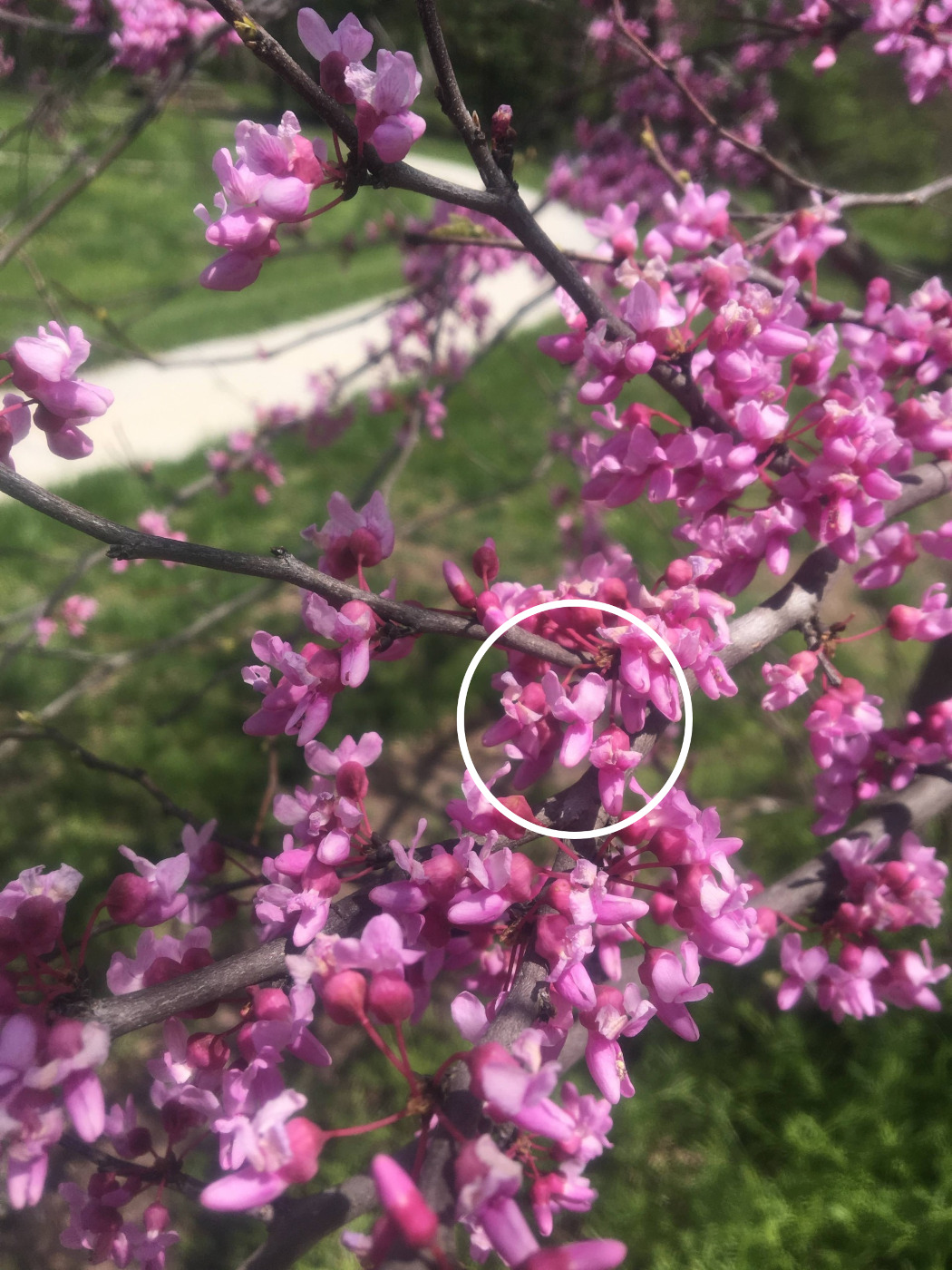
Leaves: Eastern redbud leaves are alternately arranged, leading to a zigzag look on young growth. The leaves are heart-shaped, or cordate (Photo 3). At this time of year, the leaves are barely emerging (Photo 4), but later in the year, they are a main identifiable feature. Unlike most members of the pea family, eastern redbud has simple leaves rather than compound leaves (leaves that are divided into separate leaflets).
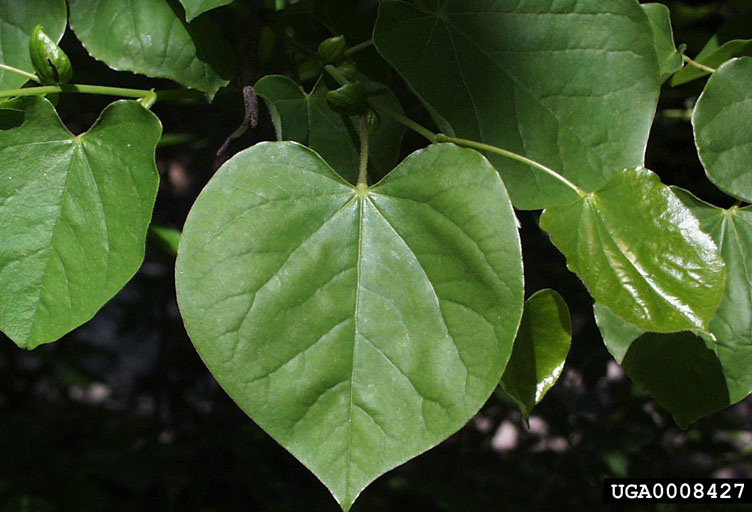
Seeds/fruit: Pods form after flowering. They start out green but will turn brown and dry by the end of summer. They look like a flattened pea pod and are about 3 inches long with a papery shell (Photo 4). Many of the pods will remain on the tree over the winter and into next spring.
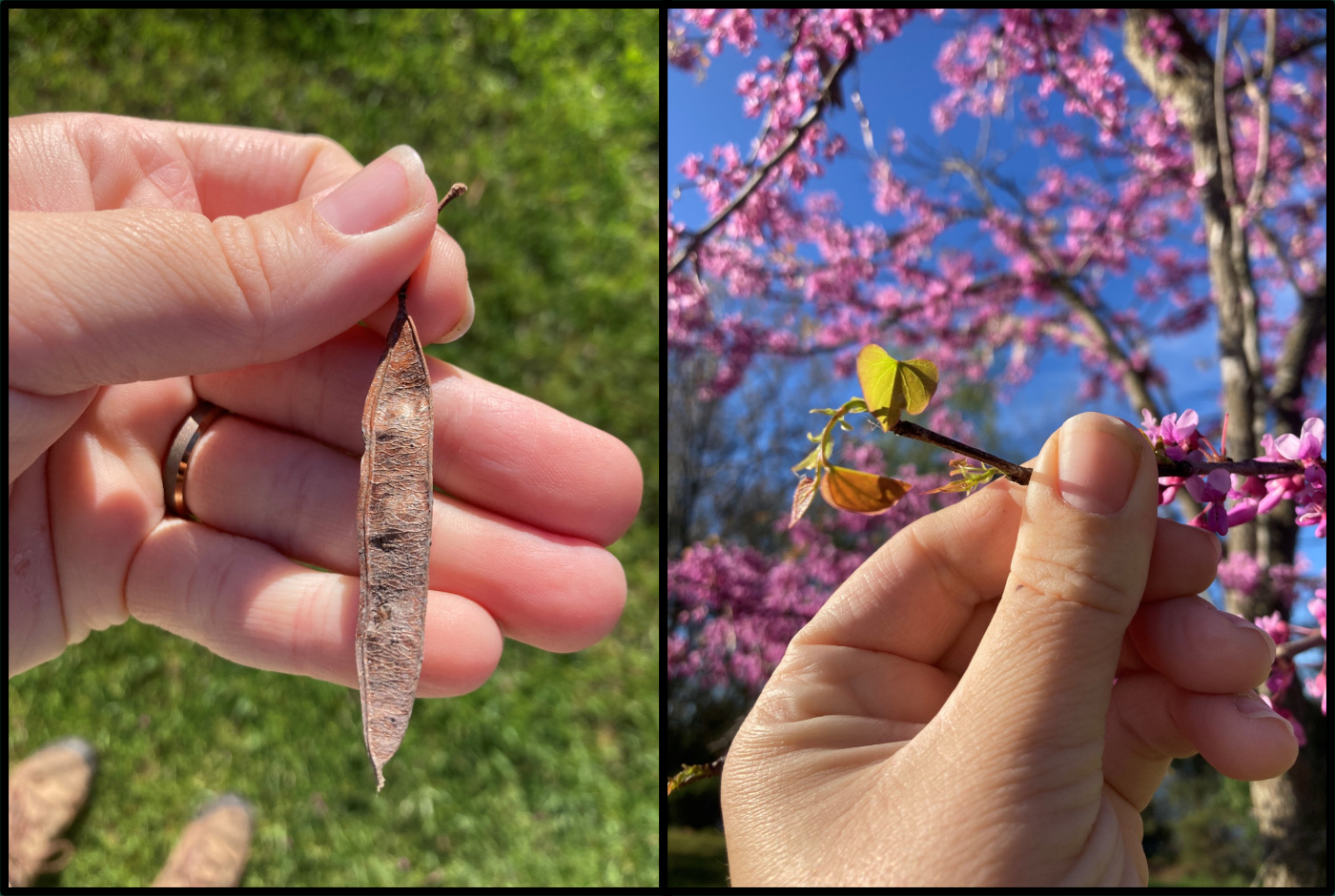
Distribution: Eastern redbud is found in much of Michigan’s lower third and throughout much of the north-central and eastern U.S. as well as southern Ontario. A popular landscaping tree, it readily spreads from plantings and is now a common plant along roadsides, forest edges, fence rows and sparse forests.
Blooming period: Eastern redbud blooms from mid- to late spring (late April to late May).
Native status: This species is native to the U.S. and Michigan.
Garden uses: Eastern redbud is a small tree that brings early season color and maintains interest year-round with its heart-shaped leaves and fluttery pods. There are many cultivars of redbud, some of which have purple leaves all year round, and others which have leaves of variable and changing colors. These cultivars also vary in size and shape (including weeping). The species typically grows 20-30 feel tall and 25-35 feet wide. The branches tend to start low on the stem, so you may have to remove lower limbs if placed in a lawn so that you can mow underneath.
Common look-alikes: In Michigan, some crabapple and peach species have pinkish-purple flowers of a similar hue. However, their petal arrangement is different, and the leaves are not heart shaped. They would not generally be found growing natively in floodplains but would more likely be seen as part of residential landscaping or occasional escapes in disturbed areas.
Garlic mustard (Alliaria petiolata)
Synonyms: garlic root, hedge garlic, penny hedge, sauce-alone
The invasive that smells like dinner
Garlic mustard is a plant with a reputation: uninvited, aggressive and nearly everywhere. Originally introduced from Europe in the 1800s for its culinary and medicinal properties, this herbaceous biennial now ranks among North America’s most prolific and problematic forest invaders. In its first year, garlic mustard produces a rosette of heart-shaped, toothed leaves that hug the ground. In the second year, it sends up a tall, branching stalk that can reach up to three feet high, topped with clusters of small white flowers.
All parts of the plant emit a distinct garlic scent when crushed, which can be a helpful clue in the field. Though once prized as a flavorful addition to meats and sauces, garlic mustard is now more likely to smother native wildflowers, alter soil chemistry, and threaten forest biodiversity. With each plant capable of producing hundreds of seeds, it spreads quickly along trails, roadsides and shaded forests.
Garlic mustard belongs to the mustard family (Brassicaceae), also known as the crucifers or cabbage family. This medium-sized botanical family includes roughly 4,000 species worldwide, many of which are native to cooler regions of the Northern Hemisphere. Economically, the Brassicaceae are heavy hitters: they give us broccoli, cauliflower, cabbage, kale, kohlrabi, collard greens and canola, among others. Members of the mustard family often share several key traits: four petals arranged in a cross shape, six stamens (four long and two short), and white, yellow or purple flowers. Their leaves are often deeply lobed or even compound. The cross-shaped petal arrangement is the source of the family’s traditional name, Cruciferae, which means “cross bearer.”
Most species are herbaceous and can be annuals, biennials or perennials. While many are cultivated for food or ornamental uses, a few non-native members — like garlic mustard and dame’s rocket — have become invasive, displacing native plants and altering ecosystems across North America (Photo 5).
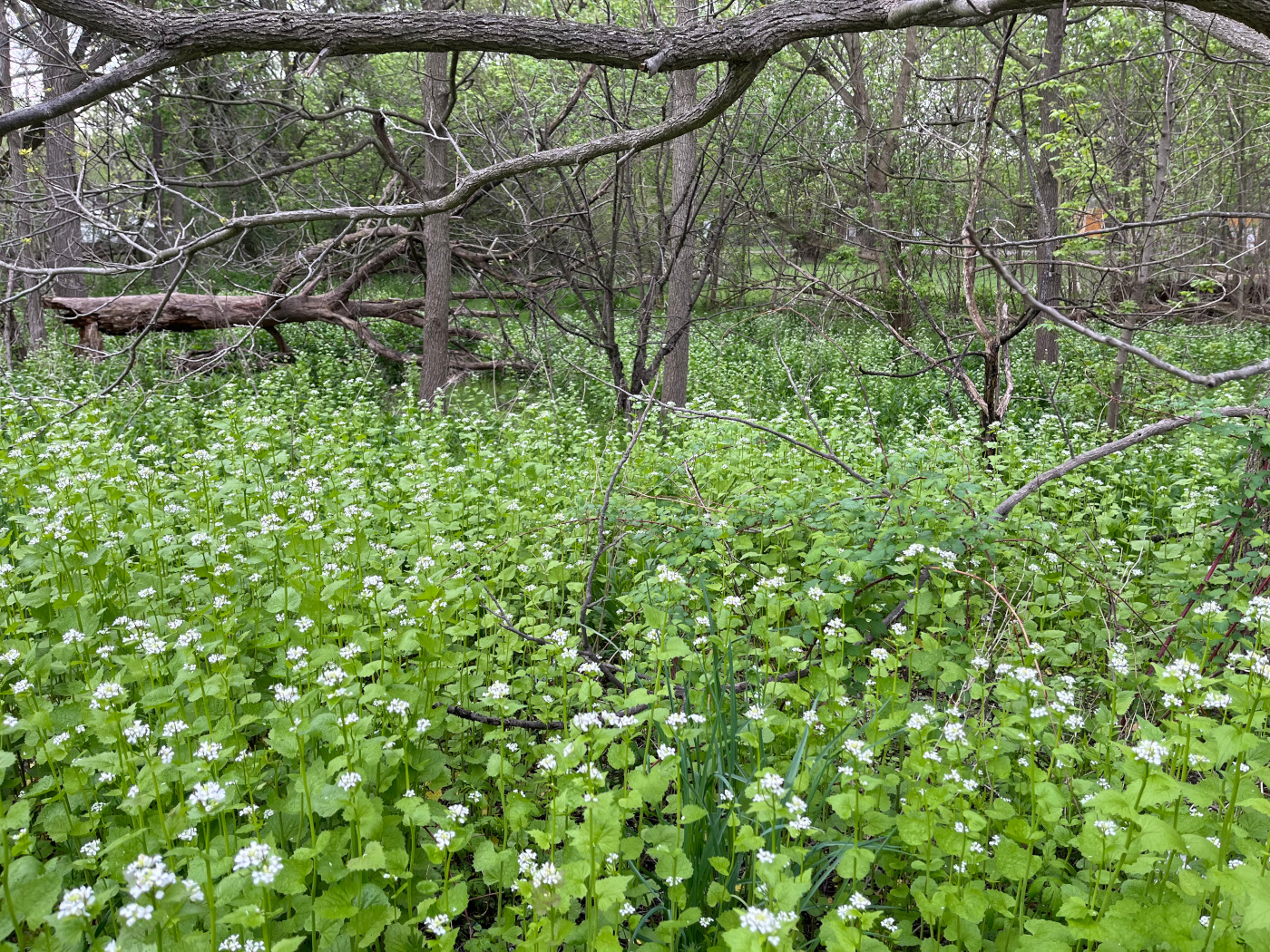
Description
Flowers: In the second year of its life cycle, garlic mustard produces small, white flowers in loose clusters (racemes) at the tops of its flowering stems. Each flower is composed of four white petals arranged in a cross-shaped (cruciform) pattern — a defining trait of the mustard family (Photo 6). Petals measure approximately 0.25 inches long and 0.125 inches wide, alternating with four smaller green sepals that are spatulate in shape (spatula- or spoon-shaped). Though modest in size, the flowers are often numerous and conspicuous.

Leaves: Garlic mustard displays two similar, but distinct leaf shapes over its biennial life cycle. In the first year, the plant forms a basal rosette of simple, rounded to heart-shaped (cordate) leaves with coarsely toothed or wavy margins and prominent deep-set veins. These rosette leaves remain green throughout winter, allowing the plant to photosynthesize very early in the spring before the forest canopy closes.
In the second year, a flowering stalk emerges bearing alternately arranged leaves that are broadly triangular to heart-shaped. These stem leaves typically range from 4 to 6 inches in length, with roughly half of that length made up by the petiole (the leaf stalk). Leaves on the lower stem closely resemble the rosette leaves, while those higher on the stem tend to be narrower but retain the characteristic coarsely toothed edges (Photo 7).
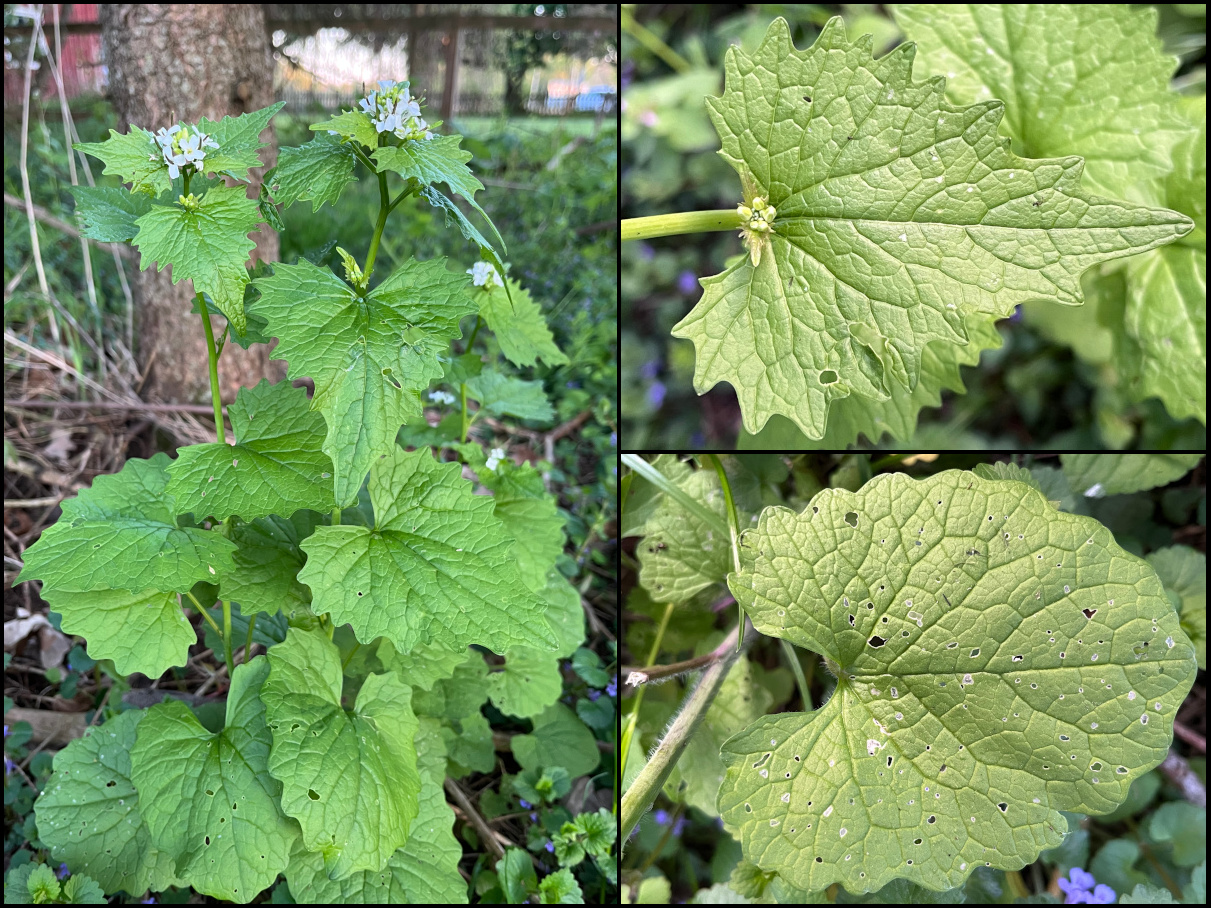
Stem/flowering stalk: The flowering stem of garlic mustard emerges in the plant’s second year, rising from the rosette to a height of 1 to 3 feet, though occasionally reaching up to 4 feet in favorable conditions. The stem is typically slender, upright and branching near the top where the flower clusters (racemes) form (Photo 7). The lower portion of the stem is sparsely covered in short, white hairs, providing a subtle but helpful identification feature. Toward the upper stem, the surface becomes increasingly smooth and may appear entirely hairless.
Seeds/fruit: Garlic mustard produces slender seed capsules known as siliques, a characteristic fruit type of the mustard family. Each silique is hairless, four-sided and typically ranges from 1.5 to 2.25 inches in length. The capsules begin green (Photo 6) and mature to a grayish-brown color as they dry.
Each silique contains two internal chambers housing 10 to 20 small, shiny black seeds. When mature, the capsule splits open along two seams to release the seeds, which may be flung several meters from the parent plant. Given that a single plant can produce hundreds of seeds, garlic mustard has a formidable capacity for colonization, especially in disturbed or shaded habitats where competition is minimal.
Roots: Garlic mustard is anchored by a slender, white taproot that often displays a distinctive S-shaped curve just below the crown (the portion of the root from which the stem arises). This subtle but consistent curvature can serve as a useful diagnostic feature, particularly when trying to distinguish garlic mustard from similar-looking basal rosettes in early spring or late fall. The root may branch modestly and is generally easy to pull from moist soil — one small consolation when removing this otherwise persistent invader.
Native status: Exotic/introduced. This species is not native to the U.S.
Distribution and habitat: A. petiolata is now firmly entrenched across much of North America. It has been documented in at least 40 U.S. states and several southeastern and western Canadian provinces. While less common in the warmest and driest regions of the continent, it remains an aggressive and adaptable invader across a wide ecological range.
In Michigan, garlic mustard has been officially recorded in 37 counties, stretching from Keweenaw County in the northwestern Upper Peninsula to Lenawee County in the southeastern Lower Peninsula. This number, however, almost certainly underrepresents its true distribution because it’s based on scientific specimens that have been collected, identified and deposited in research collections.
Garlic mustard thrives in moist, well-drained soils and favors partially shaded environments. It tolerates—and often flourishes in—deep shade, making it particularly well-suited to the forest floor. Common habitats include deciduous forests, forest edges, shaded roadsides, swampy lowlands and stream banks. Its ability to establish dense colonies in these settings makes it a formidable threat to native understory species.
Bloom period: Garlic mustard typically blooms from mid- to late spring through early summer, with peak flowering in Michigan occurring between late April and early June.
Garden uses: Despite its long culinary history in Europe where it flavored everything from salt fish to roast lamb, garlic mustard has no place in the North American garden. As a highly aggressive invasive species, it outcompetes native plants, provides little to no benefit to local wildlife, and can even be harmful to the larvae of certain native butterflies. In short: don’t plant it, pull it. While the young leaves can be turned into a surprisingly tasty pesto, Michigan State University Extension recommends limiting your interaction with garlic mustard to responsible foraging and prompt removal from your landscape. Treat it more like an edible intruder than a garden guest.
Management: Controlling garlic mustard requires patience, persistence and a bit of humility. It’s not a one-and-done kind of weed. While many excellent, detailed management guides are readily available online, the fundamental strategy remains the same: stop the plant from going to seed. Because garlic mustard spreads primarily by seed, many of which remain viable in the soil for up to a decade, prevention and early intervention are essential. Land managers strongly recommend immediate removal of new infestations before plants have the chance to flower and go to seed. Once garlic mustard becomes established in an area, long-term management becomes a years-long commitment aimed at exhausting the seed bank.
Depending on the scale of infestation, stewards typically employ one or more of the following approaches:
- Hand pulling (ideal for small patches and the go-to for homeowners)
- Cutting or mowing
- Herbicide applications
- Prescribed fire
Regardless of the method, consistency is key—effective management takes repeated effort across multiple growing seasons. Visit the Michigan State University Extension Integrated Pest Management website for a detailed discussion on garlic mustard management options.
Common look-alikes: Henbit (Lamium purpureum), creeping charlie (Glechoma hederacea), violets (Viola spp.)
Thank you to Scott Warner from the Michigan Natural Features Inventory for his review of this article.
Resources
- Michigan Flora (1985) – E. Voss
- USDA PLANTS Database (plants.usda.gov) - Alliaria petiolata, Cercis canadensis
- Weeds of the Northeast (2023) – Neal, Uva, DiTomaso, and DiTommaso
- Edible Wild Plants (2009) – Elias & Dykeman
This work is supported by the Crop Protection and Pest Management Program [grant no 2024-70006-43569] from the USDA National Institute of Food and Agriculture. Any opinions, findings, conclusions, or recommendations expressed in this publication are those of the author(s) and do not necessarily reflect the view of the U.S. Department of Agriculture.



 Print
Print Email
Email